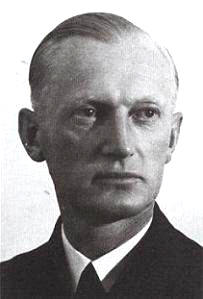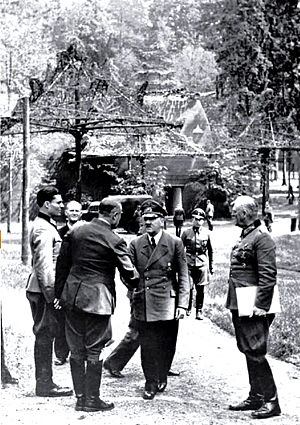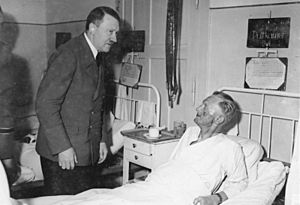Karl-Jesko von Puttkamer facts for kids
Quick facts for kids
Karl-Jesko von Puttkamer
|
|
|---|---|

Puttkamer in 1943
|
|
| Born | 24 March 1900 Frankfurt (Oder), German Empire |
| Died | 4 March 1981 (aged 80) Munich, West Germany |
| Buried |
Munich Waldfriedhof
|
| Allegiance | |
| Service/ |
Kriegsmarine |
| Years of service | 1917–45 |
| Rank | |
| Commands held | Albatros Z10 Hans Lody |
| Battles/wars | World War I World War II |
Karl-Jesko Otto Robert von Puttkamer (born March 24, 1900 – died March 4, 1981) was a German admiral. He served as a special helper, known as a naval adjutant, to Adolf Hitler during World War II.
Contents
Early Military Career
Puttkamer was born in Frankfurt (Oder), a city in Germany. His family, the Puttkamers, were related to Otto von Bismarck's wife. In 1917, he joined the Imperial German Navy as an officer cadet. This meant he was training to become an officer.
During World War I, he served on a large warship called a heavy cruiser. In December 1917, he was on the battleship Kaiserin. As the war ended, Puttkamer finished a navigation course at the Naval Academy Mürwik. He then took a break and joined a group called the Freikorps. In 1920, he went back to the Naval Academy. He officially became an officer in 1923.
Serving as an Adjutant
In September 1926, Puttkamer became the commander of a torpedo boat named Albatros. He worked under Karl Dönitz, who later became a famous admiral. Puttkamer held this command until October 1930. He was then promoted to lieutenant-commander of another torpedo boat, Adler.
In 1933, he finished a course to become a naval liaison officer. Soon after, he started working as a naval adjutant for the General Staff. This means he helped connect the navy with other parts of the military leadership. In July 1935, he moved to the staff of the Commander-in-Chief of the Navy.
Puttkamer then became Hitler's naval adjutant. He stayed in this role until June 1938. After that, he went back to active service, commanding ships.

World War II and Injury
Just before World War II started in Europe, Puttkamer was the captain of a destroyer. Once the war began, he returned to his role as Hitler's naval adjutant. This was a very important position, as he was close to Hitler.
In September 1943, he was promoted to Konteradmiral. This rank is similar to a rear admiral in other navies. On July 20, 1944, Puttkamer was injured when a bomb exploded. This happened during an attempt to kill Hitler, known as the 20 July plot. Because of his injury, he received a special award called the 20 July Wound Badge.
End of the War
In early 1945, Puttkamer briefly commanded a group of civilian soldiers called a Volkssturm battalion. These soldiers were mostly farmers, some with old uniforms and pistols, others with no weapons at all. When their train came under attack, Puttkamer realized they couldn't fight effectively. He sent his men home, deciding not to risk their lives. He felt that the old military uniform had been "dishonored" by leaders like Hitler.
On April 20, 1945, Hitler told his staff that the war situation was very bad. He ordered many of his staff, including Puttkamer, to leave Berlin by plane. Puttkamer's flight left Berlin on April 21. He was told to go to the Berghof, which was Hitler's mountain home. His job there was to destroy Hitler's private papers and belongings.
Because of this order, Puttkamer was not with Hitler during his final days in the Führerbunker in Berlin. After Germany surrendered on May 8, 1945, Puttkamer was captured by American forces. He remained a prisoner until May 1947.
Later Life
Karl-Jesko von Puttkamer passed away in 1981 in Munich, Germany. He was buried at the Waldfriedhof cemetery in Munich.
|


